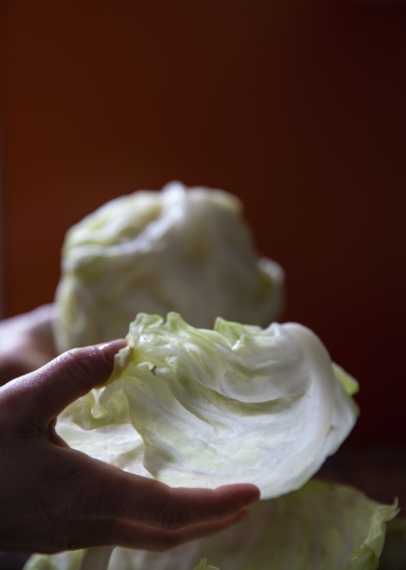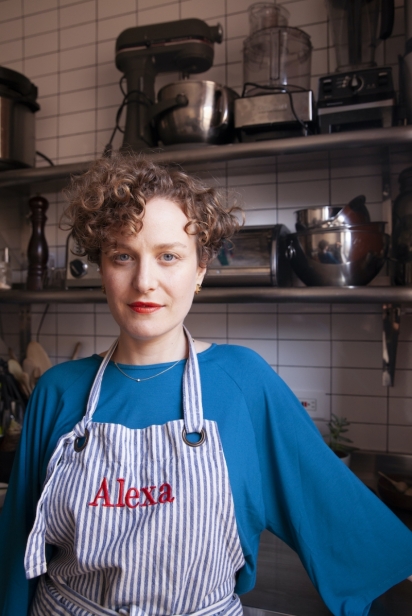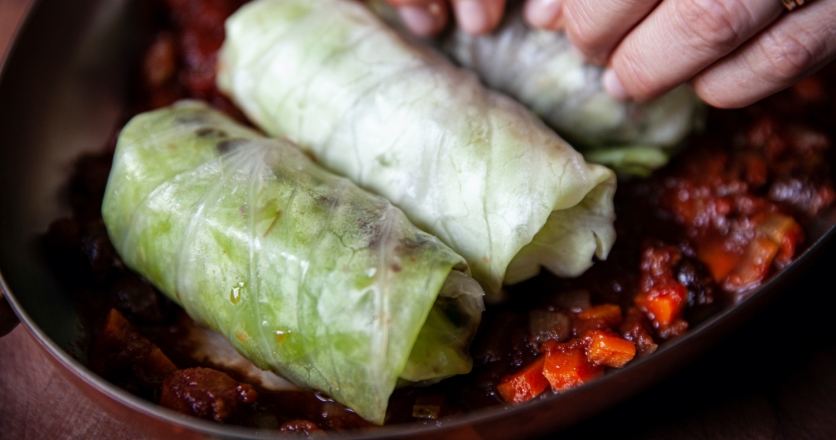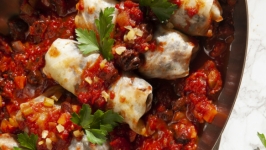Shabbat Shalom: No Meat Required
Cooking and eating can be a challenge when you’re the only vegan in a large, omnivorous Jewish family. Over the years, I’ve hosted countless Shabbat and holiday meals for family and friends with diverse dietary preferences, and my family’s dietary preference boils down to: We eat what Grandma Lisa used to make. For most of my life, my family’s holiday meals were spent at my dear Grandma Lisa’s house, where we ate animal products in all forms.
Grandma Lisa was a home economics teacher, gifted cook, skilled baker, creative craftswoman and impressive host. She hosted nearly every holiday and served us traditional German-Jewish specialties like beef rouladen, herring salad and chicken in white sauce. Grandma Lisa was still alive when I went vegan and she cried when I told her that I wasn’t going to eat her herring salad anymore. Jewish guilt is real.
When cooking for the whole family became too much for Grandma Lisa in her 80s, she delegated some holiday hosting duties to me. I was honored and committed to perpetuating Grandma’s legacy of classic German-Jewish recipes and satisfying my family, so even though I no longer ate meat, I still wanted to serve what my family expected—the requisite brisket and chicken and herring salad we always ate at Grandma’s house.
I don’t have qualms about cooking and serving meat, however I needed to eat something, so I started cooking and serving plant-based dishes for myself (and at times a cousin or two who was eating vegan or vegetarian). At first, some of my family was skeptical. More than once, my mother put something on her plate, commenting that it looked delicious, but when I told her it was vegan she removed it with a groan and eye-roll. During the decade I ate strictly plant-based, I developed and accumulated a cache of recipes for re-imagined and de-meatified traditional Jewish food, dishes that now, surprisingly, even the most carnivorous members of my family have come to love and expect. Yes—even my mother.
As the old Jewish adage goes, “they tried to kill us, we survived, let’s eat.” Jewish holidays are defined by food. Traditional Ashekenazi cuisine is many delicious things, but vegetable-centric is not the first thing that comes to mind. And while the side dishes and garnishes at a Jewish holiday table rarely contain meat or dairy, I don’t appreciate feeling dietarily marginalized and being forced to cobble together a festive meal from salads and sides, a stance I know I share with many vegans. At my table, I always serve at least one appropriate, robust main dish that works for everyone invited— whether they’re vegetarian, vegan, gluten-free or have other dietary preferences—even if that person is just me.
When veganizing an existing recipe to remove the meat, dairy or eggs, there are a few options. Using store-bought, plant-based facsimiles of dairy or meat ingredients to re-create traditional non-vegan recipes is a simple and valid method. (This isn’t always necessary for traditional Jewish cookies and cakes, since many Jewish baking recipes rely on margarine or oil; kosher laws stipulate dairy cannot be eaten after a meat meal.)
For main dishes, I prefer to forgo the fake meat category altogether and cook imaginative dishes using naturally vegan ingredients like vegetables, grains and legumes. By making a few substitutions and using some ingenuity, you too can redefine traditional Jewish foods and expand the offerings that you serve. Even if there are no vegan diners at your table, there are only winners when you offer plant-based dishes alongside the expected meat staples.
One of Grandma Lisa’s specialties was stuffed cabbage. Her dense ground beef filling (and sometimes rice, though it was omitted during Passover) was wrapped carefully in cabbage and simmered in a brown-sugar-sweetened tomato sauce studded with golden raisins. My family, and anyone who ever tasted her stuffed cabbage, went wild for the dish; we all fought over taking home leftovers. When I stopped eating meat, I knew the loss of this dish would be devastating. But the building blocks of the dish were ripe for a vegan overhaul and I turned to my kitchen to figure out a way to re-create Grandma’s stuffed cabbage: vegan version 2.0.
Grandma Lisa’s stuffed cabbage had one single vegetable: the cabbage leaf the meat was wrapped in; two if you counted the tomatoes in the sauce. I wanted my version to use many more vegetables both in the filling and in the sauce, and I knew ample fresh herbs and citrus could bring vibrance to the dish. For the filling, I don’t overthink it—I have used every kind of lentil and grain and even mixed together odds and ends from my pantry. If it’s Passover and you don’t eat kitniyot (a category of beans and legumes that some Ashkenazim avoid during Passover), you can use vegetables and quinoa and it will still be a success.
For those hosting vegans or vegetarians in your home, there’s no need to fret. Don’t succumb to buying pre-made Tofurkey or another highly processed meat stand-in when this stuffed cabbage is simple, delicious and you can make it ahead of time (it freezes well!). And for the vegan guest dining at an omnivore’s house, consider making this dish to bring to your host. I’m certain even the meat-eaters will try, and love, it.
Grandma Lisa passed away seven years ago and her absence is still deeply felt whenever I start planning a holiday menu. I learned so much about cooking, baking, serving and hosting from her. In the years I hosted while she was alive, Grandma came to my apartment for the holidays and tasted and appreciated my veganized version of her stuffed cabbage. She was proud of me for taking her dish and reimagining it. Though version 2.0 shares only the cabbage leaf and tomato sauce with her original, Grandma’s culinary legacy lives on.









